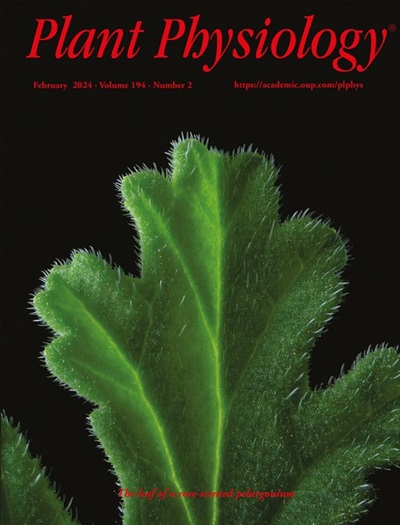microRNA858 抑制转录因子基因 SbMYB47 并调控黄芩中黄酮类化合物的生物合成
IF 6.5
1区 生物学
Q1 PLANT SCIENCES
引用次数: 0
摘要
微小核糖核酸(miRNA)是一种非编码的内源性单链 RNA,可通过减少目标基因的转录和翻译来调控目标基因的表达。植物中的一些 miRNA 在次生代谢中发挥作用。黄芩(Scutellaria baicalensis Georgi)的干燥根是一种传统中药,其主要活性成分是黄酮类化合物(黄芩苷、黄酮甙和黄芩素)。虽然黄芩的基因组序列已经公布,但有关其 miRNA 的信息还很缺乏。本研究汇编了 12 个不同黄芩组织的小 RNA 文库,包括根、茎、叶和花。共鉴定出 129 条 miRNA,包括来自 27 个 miRNA 家族的 99 条 miRNA 和 30 条预测的 miRNA。此外,利用 psRNAtarget 发现了 15 个 miRNA 家族的 46 个可靠靶基因,并通过降解组测序进行了确认。据推测,microRNA858 (miR858)-SbMYB47 模块可能参与了类黄酮的生物合成。在烟草叶片中进行的瞬时测定表明,miR858 以 SbMYB47 为靶标并抑制其表达。人工 miRNA 介导的 miR858 敲除和 SbMYB47 的过表达显著增加了黄芩毛根中黄酮类化合物的含量,而 SbMYB47 的敲除抑制了黄酮类化合物的积累。酵母单杂交和双荧光素酶试验表明,SbMYB47能直接结合并激活黄芩苯丙氨酸氨解酶3(SbPAL-3)和黄酮合成酶II(SbFNSⅡ-2)启动子。我们的研究结果揭示了 miR858-SbMYB47 模块与黄酮类化合物生物合成之间的联系,为通过代谢工程生产具有重要药理活性的黄酮类化合物提供了一种潜在的策略。本文章由计算机程序翻译,如有差异,请以英文原文为准。
microRNA858 represses the transcription factor gene SbMYB47 and regulates flavonoid biosynthesis in Scutellaria baicalensis
MicroRNAs (miRNAs) are non-coding endogenous single-stranded RNAs that regulate target gene expression by reducing their transcription and translation. Several miRNAs in plants function in secondary metabolism. The dried root of Scutellaria baicalensis Georgi is a traditional Chinese medicine that contains flavonoids (baicalin, wogonoside, and baicalein) as its main active ingredients. Although the S. baicalensis genome sequence has been published, information regarding its miRNAs is lacking. In this study, 12 small RNA libraries of different S. baicalensis tissues were compiled, including roots, stems, leaves, and flowers. A total of 129 miRNAs were identified, including 99 miRNAs from 27 miRNA families and 30 predicted miRNAs. Furthermore, 46 reliable target genes of 15 miRNA families were revealed using psRNAtarget and confirmed by degradome sequencing. It was speculated that the microRNA858 (miR858)–SbMYB47 module might be involved in flavonoid biosynthesis. Transient assays in Nicotiana benthamiana leaves indicated that miR858 targets SbMYB47 and suppresses its expression. Artificial miRNA-mediated knockdown of miR858 and overexpression of SbMYB47 significantly increased the flavonoid content in S. baicalensis hairy roots, while SbMYB47 knockdown inhibited flavonoid accumulation. Yeast one-hybrid and dual-luciferase assays indicated that SbMYB47 directly binds to and activates the S. baicalensis phenylalanine ammonia-lyase 3 (SbPAL-3) and flavone synthase II (SbFNSⅡ-2) promoters. Our findings reveal the link between the miR858–SbMYB47 module and flavonoid biosynthesis, providing a potential strategy for the production of flavonoids with important pharmacological activities through metabolic engineering.
求助全文
通过发布文献求助,成功后即可免费获取论文全文。
去求助
来源期刊

Plant Physiology
生物-植物科学
CiteScore
12.20
自引率
5.40%
发文量
535
审稿时长
2.3 months
期刊介绍:
Plant Physiology® is a distinguished and highly respected journal with a rich history dating back to its establishment in 1926. It stands as a leading international publication in the field of plant biology, covering a comprehensive range of topics from the molecular and structural aspects of plant life to systems biology and ecophysiology. Recognized as the most highly cited journal in plant sciences, Plant Physiology® is a testament to its commitment to excellence and the dissemination of groundbreaking research.
As the official publication of the American Society of Plant Biologists, Plant Physiology® upholds rigorous peer-review standards, ensuring that the scientific community receives the highest quality research. The journal releases 12 issues annually, providing a steady stream of new findings and insights to its readership.
 求助内容:
求助内容: 应助结果提醒方式:
应助结果提醒方式:


